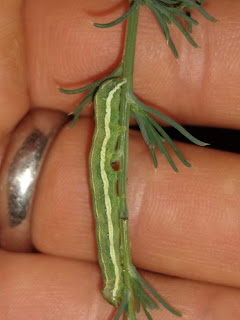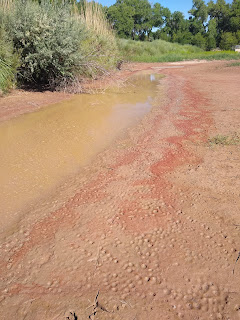There are not many raptors in the Bosque visible to me right now. However, this could just be the fact that they are harder to see during their nesting season, or it could be that during the summer there are less birds migrating through the bosque. I worry that each year there is quantifiably less and less real estate for these birds to rest and recuperate in.
An unusual raptor is this Mississippi kite. I watched it over several days hunt sphinx moths and carry them back to this perch to eat. The slim build and sleek feathers look very different than the Cooper's hawk and red tailed hawks we usually see.
The low river levels are threatening to dry up any day now. However, some animals like this heron are grateful for the isolated pools created by low water. The neck shows the classic "double C" musculature that gives this bird fast striking power with that large bill.
This egret can fish the same area as the heron and is not competition. It hunts smaller fish and insects with a beak designed to be more like tweezers
Nesting is what birds are best at. These swallows are patiently waiting for the parents to return. This nest is safely tucked up under the eves of the Corrales fire department away from snakes, cats, and predatory birds.
The young toads are not so lucky. This young wood house relies on stealth and camouflage to hunt small insects and avoid predators. Being active at night helps avoid some predators.
The young spadefoot frogs live in the dry desert and hide underground during the day. They can live off the muscle in their tail as it is resorbed. Because desert water evaporates quickly, they develop into frogs much faster than other species.
Bullfrogs live in an permanent wetlands environment with many predators, including others of their own kind. In these environments, being the big frog in a small pond is beneficial.
Wetlands can be a rich environment, especially for invasive species, but they have to be tough and adaptable. This red swamp crayfish is one of the toughest and is found at the end of Andrew's lane in large numbers. This species can survive anything and eat anything as long as there is mud as some point in the year.
Right now by the river there is a lot of mud. Some of it quite deep. Notice the pool is muddy. This should have settled out, but the tadpoles are stirring up the clay as they feed on the red algae that is visible on the shoreline as the water retreats. Muddy water attracts predator's attentions.
Looking closer, the round circles in the mud are where the tadpoles excavated small holes as they ran out of space. While rare, there is examples of this in
the fossil record. On left of the picture is a track of a heron patrolling the water's edge. As the clay begins to crack, the newly emerging frogs are found hiding in those depths to avoid desiccation in the sun.
Tough conditions are also opportunities for the animals that survive. This crayfish tried hunting the trapped tadpoles, but finally succumbed when it didn't burrow into the mud soon enough.
In the height of summer, there are many insects out and the pollination circus is in full swing. Some plants, like lavender and cactus, are pollinated by a limited number of species. Other plants like sunflowers and Spanish lace are pollinated by a dizzying variety of weird insects.
Also in that mix of activity are other insects, like this robber fly. It specializes in catching unwary insects on their way to popular flowers, these insects can tackle most large insects such as grasshoppers and dragonflies.
This is a bee mimic, it also catches insects but usually is focused on bumblebees in flight. There are also wasps that mimic bees and prey on them. It can get very confusing.
Many plants are focused on producing seeds. Some drop seeds early like this aster. If this looks a lot like a dandelion, that is because they are also in the aster family.
The common sunflower in blooming right now in places that the seeds have been scattered for birdseed. These plants support an amazing variety of wildlife. From birds, to subterranean mammals, and a cloud of pollinating and sap sucking insects. It will produce the seeds on the flower head in the fall after the petals have fallen.
The variety of wasps is impressive. There is a distinct daily order to the visitors to these large plants. Flies are most likely in the morning, then wasps, beetles and ants visit during the heat of the day, and the smaller mosquitos and midges are there in the evenings. Many insects are also courting in the leaves nearby.
This meadow salsify is showing the classic ray pattern of the aster family of plants. Sunflowers are also in this group. Most asters attract bees and almost any pollinator. The pollen and nectar is very accessible in the central pod.
This Indian paintbrush, on the other hand, is a parasitic plant and the color isn't even coming from a flower structure, they are leaves that have been modified into orange petals. Red is attractive to hummingbirds and the plant has no landing pad for insects to home in on, favoring pollinators that hover when feeding.
Out in the hot sun the rocky mountain bee plant is very distinctive, with tall stems and showy flowers. This plant has a wide range over the US is is much admired by gardeners, except for the other common name; stinkweed.
The west mesa is not a place where many domestic bees can be found, but many wasps are likely to be seen anywhere that has flowers. This Thynnid wasp is not often seen in our area. Almost all solitary wasps are harmless, even if they have prominent stingers, like this one, their minds are absorbed on other things.
A very different looking wasp was in the sunflowers in Corrales. This is a scoliid wasp species, very common. The russet thorax with stiff hairs is often used as a defense against large ants that protect the aphid colonies found in the terminal buds of growing plants
This same color and shape is in this velvet ant, which is another type of wasp. The heavy hairs are necessary as these wasps lay their eggs next to underground insect nests and often have to run a gauntlet of angry ants. They have thick exoskeletons, stiff hairs, bright warning colors, bad smells and females care a potent sting. All velvet ants seem to live a very active life.
Long horn beetles, like this Stenelytrana gigas belong to a family that has 35,000 different species. Almost all of them chew wood for a living. Some in this family grow a body that is 6.5 inches long.
This specimen is a Moneilema gigas. The yellow neck collar is pretty distinctive. These warm temperatures definitely bring out the largest of the bugs. This beetle is found in open desert terrain after dark.
The desert floor is a very weird place at night. Most people assume it is just a vast space full of nothing, but that is not true. The moths are active in pretty dense numbers, in weird colors and shapes. The desert floor is an easy place to hide in, so most people miss what is out there on summer nights. Some animals, like the kangaroo rat move so fast then can only be heard, but not seen, and good luck trying to get a photograph!
Russian thistle, aka tumbleweed, aka
Salsola tragus is from Russian originally. It has become the quintessential America plant. It harbors an impressive amount of life and also quite a few secrets. In small amounts it is edible, but in large amounts it is poisonous from oxalate compunds. The stems seem to exude a slightly sticky liquid that is definitely not sugary but appears to be related to the tiny flowers found on these plants that attracts many small moth species.
Say's stink bugs are found everywhere there is soft green plants, including many gardens. I think they are very colorful and worth looking at, but they are a pest to most people.
Right now there seems to be lizards everywhere in Corrales. Their numbers would be lower, but many of their natural predators avoid human inhabited areas. Coachwhips and roadrunners avoid Corrales bosque areas, allowing the lizards to have full rein on the ground and in the trees.
The parking area at Alameda is neither as big, or as busy as the Bachechi Space on the Albuquerque side of the bridge. Being undeveloped, many people would improve it. Here, old asphalt was put into a pothole in the mud to "improve" the parking area. Likely some contractor thought this was a good idea for the community. Unfortunately, this means the current community of triops and spadefoots that usually grow and thrive in this little oasis will no longer continue to do so.
This is just one little spot in a parking lot. However, this same idea is being planned for the whole of the interior drain in Corrales, from The Corrales Bosque trailhead, all along Andrew's lane for several miles to Wagner's lane northwards. This will eradicate thousands of species and limit access to many thousands more during migrations. Good for the community, while further shrinking the real estate available to all.


































































